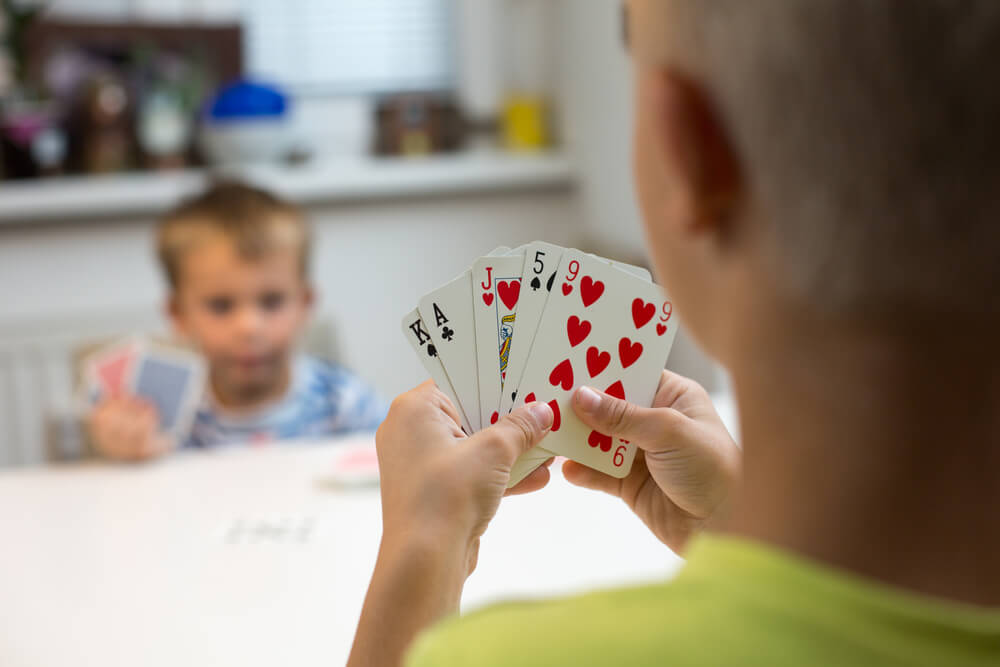Simple and Engaging Card Games for Kids and Families

Looking for some rainy day entertainment for your kids, or keen to revisit some of the games of your youth with your own kids? Card games aren’t just a great way to pass the time, but can help children learn math skills and boost memory. With so many to choose from, use our one-stop-shop guide below to check out the best card games for kids to start enjoying today.
Contents:
- How to Choose the Right Card Game for Your Child
- Best Card Games for Kids
- General Tips for Playing Cards with Kids
- FAQs
How to Choose the Right Card Game for Your Child

Impact Photography/Shutterstock.com
There are literally hundreds of card games out there, so if you’d like to introduce your kids to this type of game, choosing the right one can feel a little overwhelming. Don’t worry, we’ve got your back!
Firstly, consider your child’s age: Some card games, like Snap, have very simple rules, while others are much more complex to learn, such as poker—which can be a challenge even for adult players!
Next, take into account that some card games can be played solo, while others are best for two players, and others are perfect for the whole family to enjoy.
You may also want to assess each card game’s learning value. For example, does it help develop counting skills, boost strategic thinking, or improve memory? And are you looking for a fast-paced, exciting game, or a form of quiet entertainment to help your child relax after a busy day? Last but not least, don’t forget about the entertainment factor: if the game isn’t fun, you’ll have a hard job convincing your kid to give it a go.
Best Card Games for Kids
Easy Card Games for Preschoolers (Ages 3–5)
Snap
- Age: 3+
- Number of Players: 2+
- Equipment: None
Rules:
This classic game is easy to learn and play. The deck of cards is dealt out equally between players, who then take turns laying down cards from the top of their pile to make a new face-down pile in the middle of the table. If a card is turned over that matches a card that has just been put down by the previous player, the first person to notice this shouts out “Snap!” and wins this middle pile of cards, which they add to the bottom of their own. The aim of the game is to win all the cards.
Go Fish
- Age: 4+
- Number of Players: 2+
- Equipment: None
Rules:
Start by assigning five cards to each player and place the remainder face down in the middle of the table. The aim is to collect as many sets of four as possible before the end of the game.
When it’s their turn, a player can ask any other player for a card, as long as they already hold a card of that rank or number. If this player has one or more of the requested cards they must hand them over, and the original player can have another go. If, however, the player hasn’t got any of the requested cards, they yell “Go Fish!” and the requesting player must take a card from the center pile.
If the card they pick up is the same one they asked for, they get another go, otherwise, play passes to the next person on the left. When a player has four matching cards (such as four Queens), they must lay them face up on the table. The game is over when all the cards have been laid down in sets of four.
Old Maid
- Age: 4+
- Number of Players: 2+
- Equipment: None
Rules:
First, take one of the Queens from the deck and then deal the remaining cards between the players. Each player looks through their cards and removes any pairs they hold (such as two Jacks or two Threes) and places them face down in front of them. If a player has three of a kind, they should discard only two cards.
The person to the left of the dealer—without looking at them—takes one of the dealer’s cards. If this card allows them to make a pair, they do so and place these cards face down in front of them. Now they offer their cards to the player on their left, and the process continues.
The game ends when all the cards have been paired up except one—and whoever holds that card is the Old Maid!
Crazy Eights
- Age: 5+
- Number of Players: 2+
- Equipment: None
Rules:
The idea of this card game is to be the first player to discard all their cards. Start by dealing each player seven cards and place the remaining in a pile face down in the middle of the table, flipping the top card face up. The player to the left of the dealer goes first, with play then proceeding clockwise.
On their turn, a player must try to play a card that matches the rank or suit of the faceup card on the discard pile—if unable to do so, they must draw cards from the discount pile until they can!
The eights are wild cards—if someone plays an eight they can choose any suit with the next player required to play a card of this suit.
Fun Card Games for Early Elementary Kids (Ages 6–8)
Slapjack
- Age: 6+
- Number of Players: 2
- Equipment: None
Rules:
Start by dealing the cards equally between the players, face down. Each player now takes a turn to flip over the top card from their pile, to create a new face-up pile of their own. When a player turns over a Jack, all players must try to be the first to cover the pile with the Jack with their hand and yell out “Slapjack!” The first to do so wins that pile of cards, which must be shuffled and added to the bottom of their own pile.
Should a player, by mistake, put their hand over a card that isn’t a Jack, they have to give a card to the player whose card they “slapped.”
If a player runs out of cards they have just one opportunity to remain in the game when the next Jack is played, otherwise they are out of the game. The winner is the last remaining player in the game.
Solitaire
- Age: 7+
- Number of Players: 1
- Equipment: None
Rules:
To get started with this classic solo game, deal out the cards in a row from left to right, with the first card face up and the following six face down. Next, lay a card face up atop (and slightly overlapping) the second card followed by five more cards on top of the other cards, face down. Repeat this process until there are seven cards on the seventh pile, with the bottom card face up. Be sure to leave enough space for four “foundation piles”—a pile for each suit.
Now it’s time for the game to start. The aim of Solitaire is to move all the cards to the foundation piles—but this will take some work! Players must stack cards in number order, in alternating suits. For example, a black two can go on top of a red three. Once a pile is empty, a King of any suit can be put in the empty space.
If the player uncovers an Ace, it can be moved to a foundation pile—these are stacked in reverse order, so a Two of Diamonds goes on top of an Ace of Diamonds.
When no more moves can be made, the player turns over a card from the pile of remaining cards and, if possible, places it on one of the piles. If it can’t be placed, another card is turned over. The aim of the game is to have all cards on one of the foundational piles—but bear in mind that this is not always possible!
Seven-Card Rummy
- Age: 7+
- Number of Players: 2+
- Equipment: None
Rules:
Deal seven cards to each player and place the remaining cards in a stack, face down, in the middle of the table. Flip the first card in this stack face up. The aim of the game is to hold one set of three cards, and one set of four, at which point a player can yell “Rummy!” and be declared the winner. A set can be a run of three or four cards in the same suit, or be three or four of a kind.
The player to the left of the dealer begins by either taking the face-up card from the stack in the middle or choosing the next card (that’s face-down) from the top of the pile. They then discard one of their cards and the play moves to the next person on the left.
The game continues until someone shouts “Rummy!”—if the stack in the middle runs out, just turn over the pack and keep going until there’s a winner!
Classic Card Games for Older Kids (Ages 9–12)
War
- Age: 9+
- Number of Players: 2
- Equipment: None
Rules:
Start by dealing out the cards equally between the two players. Players should not look at their cards. Together, players count down from three and flip their top cards at the same time. The player with the highest card is the winner, takes both cards and places these cards on the bottom of the pile. If players flip a card of the same value (such as two Fours or two Queens), a “war” begins.
When it’s a war, each player places another three cards, face down, next to their already flipped card. Next, each flips over a fourth card face up. Whoever’s fourth card has the highest value is the winner, with this player collecting all ten cards laid out. Should a player not have enough cards for a war, they simply place their final card face up. The game is over once one of the players collects all the cards—this player is the winner of the war!
Hearts
- Age: 12+
- Number of Players: 4
- Equipment: Pencil and paper to keep score
Rules:
Hearts is unusual as the winner is the player with the lowest score. On each hand, the aim is to avoid gaining any tricks including the Black Maria (the Queen of Spades) or any Heart card or to win the Black Maria and all thirteen Heart cards.
Start by handing out thirteen cards to each player. Each player then looks at their cards, selects three, and hands them face down to another player. Before looking at the cards they have received from an opponent all players must have passed their cards. The first-hand goes to the player on the left, the second to the player on the right, and the third to the player across the table, and there is no passing for the fourth hand.
Whichever player holds the Two of Clubs (after the pass) plays this card to start the first trick, with each player following suit where possible. If a player holds no cards in this suit they may discard any card of another suit—a Heart or the Black Maria, however, may not be discarded at this point in the game.
The winner of the trick is the player with the highest card of the led suit. This player keeps all the cards won in a face-down stack in front of them, and begins the next trick. The Heart suit may not be led until the Black Maria or another Heart has been played—the Black Maria may be led at any time.
Once each hand ends, the number of Hearts each player holds is added up (each Heart is worth one point)—the Black Maria is worth thirteen points. If a player has the Black Maria and all thirteen Hearts they may subtract twenty-six points from their score and add twenty-six points to every other player’s score.
Typically played to one hundred points, Hearts ends when one player reaches this score, at which time the player with the lowest number of points wins.
Euchre
- Age: 12+
- Number of Players: 4
- Equipment: Pencil and paper to keep score
Rules:
Euchre is played with four players, split into two teams of two. Start by removing all cards apart from Aces, Kings, Queens, Jacks, Tens, and Nines from the deck. Players play one card per turn during each round—this is called the “trick.”
Once everyone has played their cards, the player with the highest value card wins the trick, with teams accumulating points at the end of each round based on the number of tricks they win. The first team to reach ten points wins the game.
Five cards are dealt to each player. The dealer flips the top card of the remaining deck to show the potential trump suit. Each player can now decide whether they want to accept this potential trump. If a player accepts, the revealed card is added to their hand and they discard, face down another card. If a player rejects the suit, they can pass it to the next player to make a decision.
In terms of scoring, a team receives one point should they win three or four tricks; two points are earned if the team wins all five tricks of the round. As defenders, by preventing a team that chose or accepted the trump suit from getting the majority of tricks, a team earns two points.
General Tips for Playing Cards with Kids

urbans/Shutterstock.com
Use these tips to help you get started playing card games with your kids, for the most enjoyable experience (for everyone!) possible:
- If your child is completely new to card games, start slowly, and choose a game that’s right for their age and abilities to avoid frustration.
- Keep things light and fun—it’s probably best not to emphasize any educational aspect or put pressure on kids to master the rules or skills required quickly.
- It can be helpful to write down the rules in a simplified form, so kids can refer to these if they get stuck.
- While children are new to a particular card game, it’s a good idea to supervise the first few rounds if they’re playing with siblings or friends. It is also important to be on hand if a child is struggling to remember rules; this can also keep arguments from breaking out.
- Try mixing things up with card games like Uno, which are also good for promoting skills such as strategic thinking—and are super fun too.
Card games are a great way to bond with your kids, but what about when they’re out and about? With the Findmykids app, you can keep track of your child’s location in real time, set safe zones, and get alerts when they arrive at or leave a location. Whether they’re playing at a friend’s house or heading to an after-school activity, you’ll always know they’re safe.
⠀
📲 Download Findmykids today and enjoy peace of mind while your little ones enjoy their adventures—both at the card table and beyond!
Upping the Entertainment Factor with Great Card Games for Kids
Introducing some card games into your entertainment repertoire is a great idea. As well as giving kids a new fun pastime, such games are also effective ways to develop skills like counting, memory, strategic thinking, patience, and more.
Choose the best card game for your child based on their age and ability, start slowly, and keep things fun, and your kid is sure to become a fan. This is great news when you need a little peace to get dinner made or you’re dealing with a rainy day whilst on vacation!
What are your kids’ favorite card games? Are there any that we’ve missed that should be on our list? We’d love to hear your thoughts; drop us a line in the comments box below.
FAQs

MIA Studio/Shutterstock.com
What card game can a 5-year-old play?
There are plenty of card games that 5-year-olds are likely to be able to play and enjoy. Snap, Old Maid, and Crazy Eights are great options for this age group, as they all have simple rules and are fun and fast-paced.
What is the easiest game of cards to play?
Snap is generally the easiest game of cards to play and is a good introduction to card games for kids. It has very simple rules which are easy to remember, and gameplay doesn’t take too long.
What is the most beginner-friendly card game?
Snap is a very beginner-friendly card game, as is Old Maid and Crazy Eights. For slightly older kids, Slapjack is also a fun card game to introduce.
Cover image: pikselstock/Shutterstock.com
Проверьте электронный ящик



















